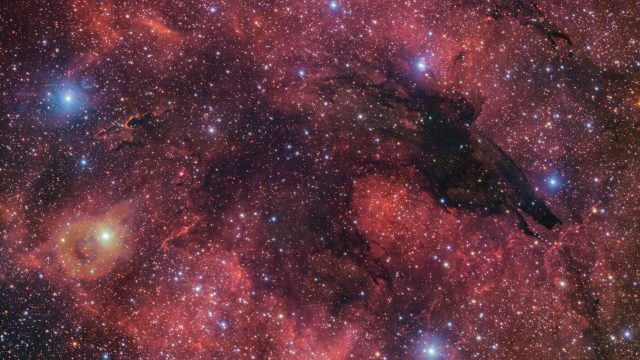
Europejskie Obserwatorium Południowe wykonało inspirowane Halloween zdjęcie Mgławicy Ciemny Wilk, zniewalającej gęstej chmury kosmicznego pyłu w gwiazdozbiorze Skorpiona.
Ta ciemna mgławica, znajdująca się 5300 lat świetlnych od Ziemi, pojawia się na żywym tle, przypominając wilka czającego się w gwiazdach. W przeciwieństwie do innych mgławic, ciemne mgławice pochłaniają światło, przepuszczając jedynie promieniowanie podczerwone.
Mgławica Ciemny Wilk
Halloween może się już skończyło, ale to nowe, zapadające w pamięć zdjęcie opublikowane przez Europejskie Obserwatorium Południowe ([{” attribute=”” tabindex=”0″ role=”link”>ESO) should not be missed. It features a dark nebula that resembles a wolf’s silhouette against a vibrant cosmic background. Appropriately named the Dark Wolf Nebula, this striking image was captured in a detailed 283-million-pixel shot by the VLT Survey Telescope (VST) at ESO’s Paranal Observatory in Chile.
The Dark Wolf Nebula lies in the constellation Scorpius, near the center of the Milky Way, about 5,300 light-years from Earth. This image covers an area of the sky about the size of four full Moons, yet it represents only a portion of the larger Gum 55 nebula. Looking closely, the nebula’s wolf-like shape even hints at a werewolf, its hands eerily reaching out as if ready to grab any lingering stargazers.

What Are Dark Nebulae?
If you thought that darkness equals emptiness, think again. Dark nebulae are cold clouds of cosmic dust, so dense that they obscure the light of stars and other objects behind them. As their name suggests, they do not emit visible light, unlike other nebulae. Dust grains within them absorb visible light and only let through radiation at longer wavelengths, like infrared light. Astronomers study these clouds of frozen dust because they often contain new stars in the making.
Of course, tracing the wolf’s ghost-like presence in the sky is only possible because it contrasts with a bright background. This image shows in spectacular detail how the dark wolf stands out against the glowing star-forming clouds behind it. The colorful clouds are built up mostly of hydrogen gas and glow in reddish tones excited by the intense UV radiation from the newborn stars within them.

Observing Dark Nebulae and Their Significance
Some dark nebulae, like the Coalsack Nebula, can be seen with the naked eye – and play a key role in how First Nations interpret the sky[1] – ale nie Mroczny Wilk. Powyższe zdjęcie wykonano przy użyciu danych z teleskopu VLT Survey Telescope, który jest własnością Narodowego Instytutu Astrofizyki we Włoszech (INAF) i znajduje się w Obserwatorium Paranal na chilijskiej pustyni Atakama. Teleskop wyposażony jest w specjalnie zaprojektowaną kamerę do mapowania południowego nieba w świetle widzialnym.
Zdjęcie powstało ze zdjęć wykonanych w różnym czasie, każde z filtrem przepuszczającym inną barwę światła. Wszyscy zostali schwytani podczas tzw Fotometryczne badanie VST Hα południowej płaszczyzny Galaktyki i wybrzuszenia (VPHAS+), który zbadał około 500 milionów obiektów w naszej Drodze Mlecznej. Tego typu badania pomagają naukowcom lepiej zrozumieć cykl życia gwiazd w naszej macierzystej galaktyce, a uzyskane dane są udostępniane publicznie za pośrednictwem Portal naukowy ESO. Odkryj tę skarbnicę danych samodzielnie: kto wie, jakie jeszcze niesamowite kształty odkryjesz w ciemności?

Notatki
- Mieszkańcy Mapuche z południowo-środkowego Chile nazywają Mgławicę Worek Węgla „pozoko” (studnia), a Inkowie nazywali ją „yutu” (ptak podobny do kuropatwy).




